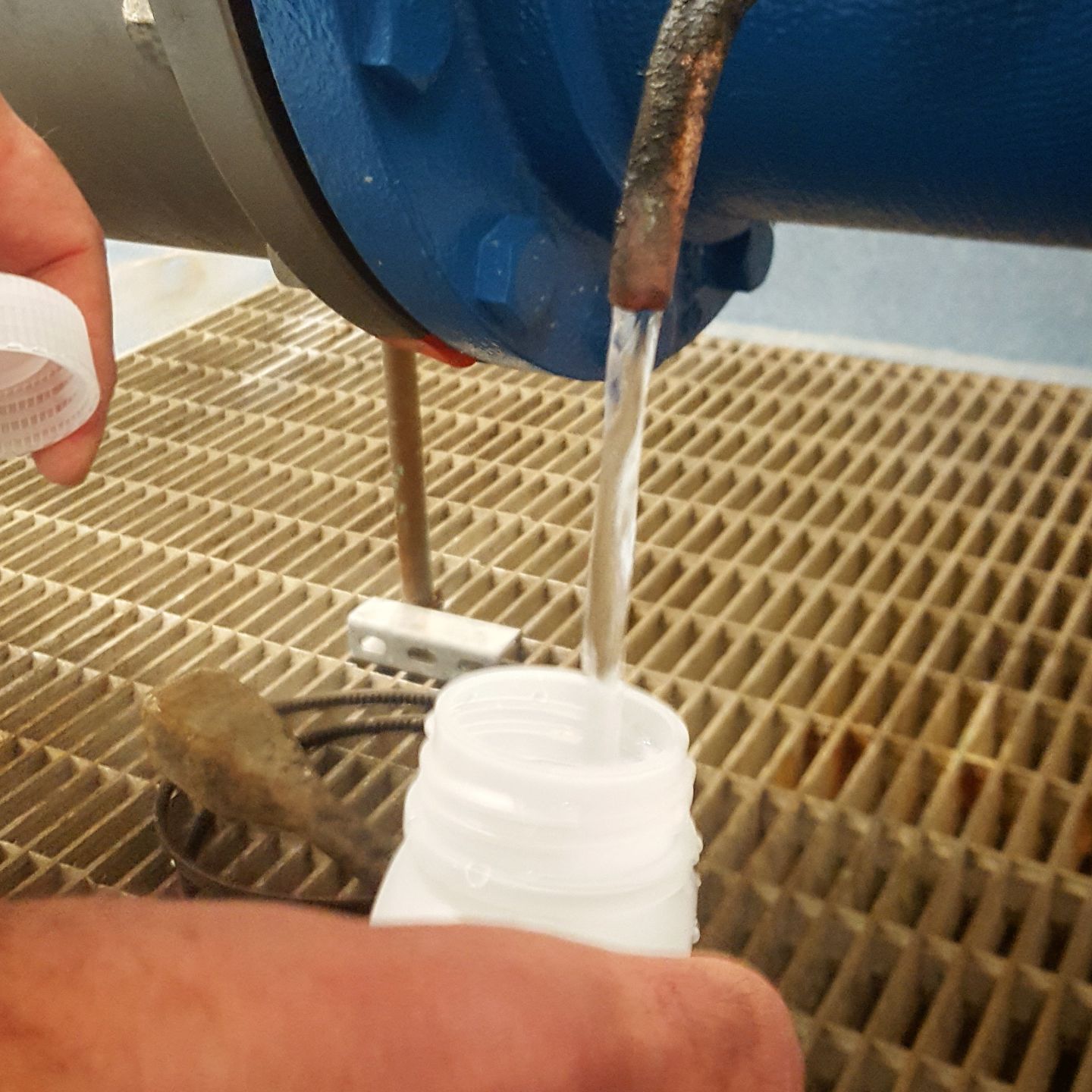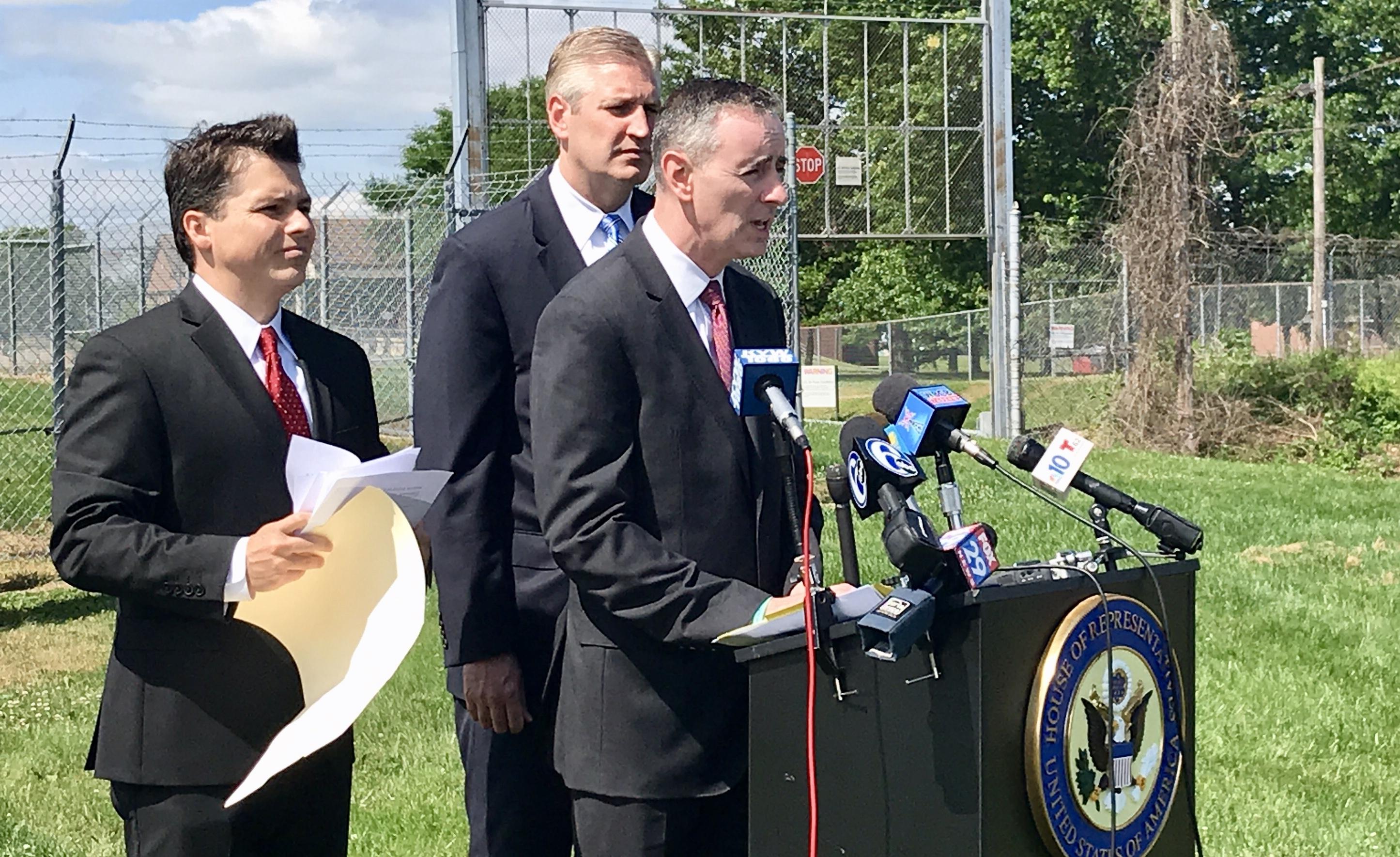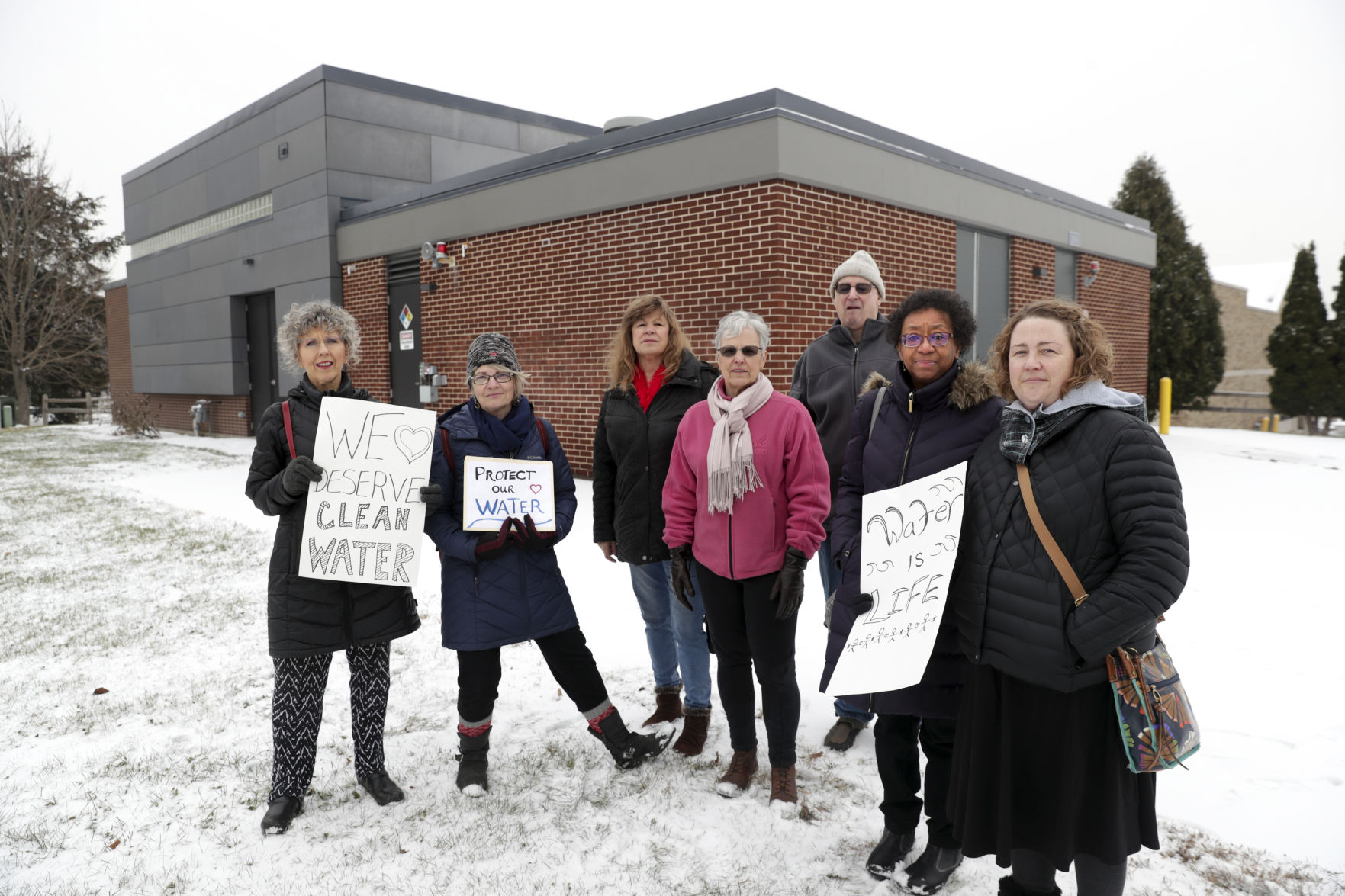
Lack of EPA regulation leaves states stumbling
As several states begin fighting with the U.S. military over growing firefighting chemical contamination within their borders, others are struggling to even devise a strategy after decades of reliance on the Environmental Protection Agency to set safety standards.
In states as diverse as Alaska, Pennsylvania and Wisconsin, regulators find themselves hamstrung by a lack of knowhow and staffing, or restricted by state laws from moving quickly. Meanwhile, the toxic firefighting chemicals known as per- and polyfluroalkyl substances, or PFAS, continue to slip off military bases and into the environment, reaching wildlife and humans exposed through drinking water. Some studies have linked PFAS to a variety of health effects, including high cholesterol, ulcerative colitis, reproductive and developmental issues, and some cancers.
Those frustrated by the efforts, such as state Rep. Todd Stephens, R-151, of Horsham, lay the blame at the feet of the EPA, which has not yet acted to create standards for the chemicals five years after they were first discovered in the drinking water of millions of Americans during a nationwide testing program.
“I’ve been asking the bureaucrats at the EPA for years to address the issue, and they haven’t,” Stephens said.
But Stephens is also well-attuned to the difficulties of tackling PFAS at the state level. For the past several years, legislation he and colleagues have introduced in the Pennsylvania statehouse to tackle PFAS contamination have all been shot down by opposing interests.
Tim Hagey, general manager of the Warminster Municipal Authority, whose wells were contaminated with some of the highest levels of PFAS in the nation after the chemicals were used at the former Naval Air Warfare Center Warminster, says he’s heard from colleagues in other parts of the state who are lobbying against efforts to establish standards.
“They say, ‘You’ve got the Navy helping you pay for it. Nobody’s going to help us pay for treatment,’” Hagey said.
State regulatory agencies attempting to get on top of PFAS issues also face challenges. In Wisconsin, state Department of Natural Resources officials say they have legal authorities they could potentially use to compel cleanup, but would have a stronger case if there was federal regulation from the EPA, an agency they have historically relied upon. The state has backed off earlier warnings to the military in favor of recently signing a renewed joint-funding agreement.
“We’re always better off when we have a health-based standard we can point to,” said Steve Elmore, who directs environmental management programs for water and groundwater in the state.
For its part, the EPA has said it is working on a robust response to the issue. Earlier this year, the agency rolled out a PFAS Action Plan, through which administrator Andrew Wheeler says he intends to establish a nationwide drinking water limit for the chemicals and is considering other regulations, such as listing PFAS as hazardous substances under the Superfund program. Asked to comment on the ongoing struggles of states, EPA spokeswoman Andrea Drinkard said the agency is moving through the process "as expeditiously as possible."
"In the interim, the agency intends to support states as we prioritize prevention and remediation programs to support local communities currently facing PFAS challenges," Drinkard added. “EPA supports states and tribes as they take appropriate actions to address PFAS in their communities."

Pennsylvania
In Pennsylvania, lawmakers and the Department of Environmental Protection agree they can’t afford to wait for the EPA to act. But there is little agreement around what exactly to do and how quickly to do it.
First-term state Sen. Maria Collett, D-12, of Lower Gwynedd, said she will imminently introduce a pair of bills in the state legislature. The first would set a state drinking water standard for four kinds of PFAS at 10 parts per trillion (10 ppt), which is a fraction of an EPA health advisory level of 70 ppt for perfluorooctanoic acid (PFOA) and perfluorooctane sulfonate (PFOS).
The second bill would add PFAS to the state’s Hazardous Sites Cleanup Act, while also permitting the governor to declare an emergency, similar to a natural disaster such as a flood, for water sources impacted by PFAS above 10 ppt. The governor could then establish drinking water or cleanup standards for the affected area, which could allow a more narrow approach than a statewide regulation.
“The real vulnerability is for the people that have been living with this exposure in the hundreds and thousands of parts per trillion in their drinking water,” Collett said.
Timothy Bergére, an environmental attorney in Pennsylvania who previously worked for the DEP, helped to draft the legislation. He says the combination of a hazardous substances listing and a drinking water limit lower than the EPA’s advisory would provide a powerful one-two legal punch, enabling the state, impacted towns, or even private citizens to seek a claim against the military. But due to quirks in the law, both would need to be in place to have strong legal standing.
“It would allow any person, including municipalities and water authorities, to recover their costs of investigating and remediating releases of PFAS,” Bergére said.
The hazardous substances listing will likely have a companion bill in the state House, where state Rep. Todd Polinchock, R-144, of Chalfont, says he has circulated a co-sponsor memo to build support among colleagues prior to introducing legislation.
But so far no representatives have signed onto Collett’s 10-ppt drinking water proposal. Stephens said he intends to introduce a measure calling for the complete elimination of PFAS, and state Rep. Tom Murt, R-152, of Upper Moreland, introduced legislation in prior sessions to set PFOS and PFOA standards at 5 ppt.
Complicating the matter, no such bills have previously advanced past committee, with supporters saying the legislation primarily received pushback from water utilities concerned the standards would result in an expensive, unfunded mandate.
Bergére takes issue with such thinking, saying other communities would be empowered to find a polluter to pay and that it’s better to know what hazards exist.
“There’s an element of that, which to me, has to be a concern,” Bergére said. “That it’s OK that you’re drinking contaminants as long as they’re not regulated.”
But Collett says she thinks the "tide is shifting" on the issue in Harrisburg from prior sessions, as PFAS is being found in more communities across the state. And she adds that while lawmakers and DEP haven't coordinated on their efforts, that doesn't mean there's any animosity.
"I view them as partners, not competitors, and I think they see me the same way," Collett said. "We're all working our hardest to pursue every possible avenue that we can think of to bring relief to the victims of this crisis."
Others have sought ways around the perennial hurdles that come with creating regulations. Last session, Stephens introduced legislation that would give municipalities the ability to redirect tax revenues generated from redevelopment of land affected by PFAS contamination from military facilities in order to offset the costs of cleanup. The bill cleared committee, but was ultimately voted down by what Stephens said were election season motivations. He intends to reintroduce it this session.
“There are some slight tweaks to try and address some of the concerns that were raised,” Stephens said, adding it would have a broader scope to appeal to more lawmakers.
At the DEP, secretary Patrick McDonnell announced over the past year that the department will set a state drinking water limit and environmental cleanup standards. But the DEP has not previously set its own drinking water limits for any chemicals, and is struggling to hire scientists it says it needs to make any regulations legally defensible. Even then, the DEP says it is required by state law to go through a formal process that requires time for a cost-benefit analysis and public input.
“Establishing a (drinking water standard) is not a simple task and we are committed to proposing a standard that is appropriate and defensible,” said spokeswoman Elizabeth Rementer, adding it could take two years. “Given the significant health implications involved for Pennsylvania residents, DEP is moving forward as quickly as possible while adhering to the legal requirements.”

Environmental cleanup standards face similar timelines. Troy Conrad, director of the DEP’s Environmental Cleanup and Brownfields program, said this week the department has already drafted soil standards and will recommend them to its Environmental Quality Board this fall. That would setup a possibility for formal adoption in late 2020.
But Bergére believes the DEP could already be acting to stem the flow of PFAS chemicals off former military bases in Bucks and Montgomery Counties using a different authority. Under the state’s “Act 2” regulations, the EPA’s 70-ppt drinking water advisory automatically becomes a groundwater standard, and the state’s Clean Streams Law gives it the ability to order the military to stop allowing PFAS to leak from the bases into off-base waterways like Horsham's Park Creek, Bergére says.
“Every molecule, even at 2 ppt, of PFOA going to Park Creek violates the Clean Streams Law,” Bergére said, adding he believes the DEP is declining to issue a violation to the military out of discretion. “By statute there’s just no doubt about it.”
The DEP agrees a 70-ppt groundwater standard exists, and said it has used its Clean Streams authority where “appropriate to do so." Rementer added the DEP is requiring the Air Guard Station to obtain a permit to treat groundwater and stormwater coming from the base.
But Rementer said that because the Navy’s adjacent Willow Grove facility is closed, the EPA is the lead agency overseeing any discharges there.
“DEP has been working cooperatively with EPA, the Navy, and the Air National Guard,” Rementer said, noting the EPA sent letters in March to the Department of Defense “requesting that they develop and implement plans for continued surface water monitoring on both facilities and, in the case of the Horsham Air Guard Station, a plan for controlling the movement of contaminated groundwater offsite.
“DEP strongly supports these requests,” Rementer added.
Bergére said he believes the EPA’s involvement at Willow Grove doesn’t preclude the DEP from taking action.
"Every discharge off of that site into Park Creek is a violation of the Clean Streams Law, every single day," Bergére argued.

Wisconsin
In Wisconsin, the state Department of Natural Resources is also struggling to figure out how to address PFAS concerns. In 2018, the department did an abrupt about-face and dropped demands the military conduct a prompt and thorough cleanup of a mile-long PFAS plume stretching from the Truax Air National Guard base, in Madison, to a municipal well serving thousands of people.
Under Wisconsin law, the DNR can require polluters to conduct cleanups even though the state hasn't yet established a statewide groundwater standard for PFAS, said the DNR's Christine Haag. The state's hazardous spill law allows the department to work with polluters to set site-specific standards, but experts say the process is more tenuous without a formal, statewide standard.
The DNR has asked the state Department of Health Services to recommend groundwater and wastewater standards, which the DNR could put in place as administrative rules. However, under a 2011 state law that shifted power away from the DNR and toward the legislature and outside interests, it can take two to three years to establish an administrative rule.
The DNR has even less leverage to try and compel the military through any drinking water provisions, as another state law allows adoption of statewide drinking water standards only if they have been previously established by the federal government.
Still, last spring, the department’s hazardous spills cleanup section was preparing to enforce a PFAS cleanup using site-specific standards developed for the Truax base. The department sent several letters to Air National Guard, putting it on notice of initial cleanup deadlines and pointing out shortcomings in the military's plan for investigating the extent of the pollution.
“The longer contamination is left in the environment, the farther it can spread,” the DNR said in an April, 2018 letter to leaders of the Truax Field installation. “Quick action may lessen damage to your property and neighboring properties and reduce your costs.”
The DNR warned of possible enforcement action if Truax didn’t meet deadlines of 30, 60 and 90 days to provide detailed mapping of the plume’s dimensions, its direction of movement, and its sources on the base.
Two weeks later, Michael Schmoller, a DNR program manager, pointed out six shortcomings in a work plan Truax had submitted. The military needed to add testing of multiple contamination sources, sample shallow and deep groundwater under the base and install monitoring wells beyond the base boundaries, especially to the southeast where the municipal well was contaminated.
Schmoller invited Truax officials to discuss the changes, but said in an interview he never heard any response. He soon learned that the DNR’s deadlines and demands had evaporated after an official in the office of DNR Secretary Preston Cole signed an agreement with the military on May 28.
The deal updated an existing Defense State Memorandum of Agreement, which was first signed in 1992 to deal with cleanups of other contaminants at several bases.
George Meyer, who was administrator of the DNR’s enforcement division at the time and then served as secretary from 1993 to 2001, said in an interview that the state would renew the agreement every few years. He added Wisconsin had little leverage over the federal government and that signing the agreements made the state eligible for payments from the military to cover the costs of overseeing cleanups.
The state Legislature, through its joint funding of the Wisconsin Air National Guard, could also work to increase funding and speed up the PFAS response. But Meyer, who is now the executive director of the Wisconsin Wildlife Federation, said state lawmakers have been slow to pay for cleaning up sources of pollution.
Meanwhile, there has been no visible progress on investigating the extent and movement of the Madison plume or its expected future impact on drinking water or the city's chain of lakes, which are popular fishing destinations.
The base is also just one of five military sites in Wisconsin, where PFAS has been found in groundwater at levels as high as 121,000 ppt trillion.
At least a few members of the Legislature’s Republican majority have been expressing concern about PFAS. But business interests are urging the state to move slowly to allow scrutiny of any changes.
Alaska
In Alaska, regulators last fall outlined plans to tighten state PFAS cleanup standards, but similarly to Wisconsin, the state Department of Environmental Conservation put them on hold in February.
Like in other states, much of the PFAS contamination in the state has been found around military installations. It’s also been found at airports, industrial sites and firefighter training areas where PFAS was used.
Many of these sites are located in and around Fairbanks, where water testing around known places of PFAS contamination in recent years have revealed 283 private drinking water wells that had PFAS concentrations above the EPA advisory level.
Laura Achee, the spokeswoman for Alaska’s Department of Environmental Conservation, said in an email that the reason for the delay is to evaluate how pending federal EPA regulations will address PFAS. The state appears to have more faith in the EPA’s intentions than states such as Pennsylvania.
“The Alaska Department of Environmental Conservation is pleased that the EPA is now taking the lead — the agency’s recently announced PFAS Action Plan is welcome news on this emerging and complex issue,” Achee said.
Pam Miller, executive director of the Anchorage-based advocacy organization Alaska Community Action on Toxics, recently learned about the delay in the state PFAS standards.
"I find it unconscionable that they're delaying given that other states are moving rapidly to establish protective, enforceable standards, including drinking water standards,” she said.
In the past, Alaska has been proactive with PFAS regulations. In 2016 the state established cleanup standards for two of the most common types of PFAS, chemicals known as PFOA and PFOS.
The pending Alaska rules would have expanded the types of PFAS that the cleanup standards apply to. They also would have required PFAS polluters to clean up soil and groundwater in locations where the concentration of five PFAS chemicals exceed 70 ppt, as well as add a sixth type of PFAS at higher concentrations.

Miller’s organization advocated for PFAS rules much stricter than 70 ppt, but she says they were looking for any state standards due to the slow pace of federal PFAS regulation. Miller sees the state’s decision to delay its regulations as a reversal from policies under former independent Gov. Bill Walker. Public comment on the state PFAS regulations closed just before new Alaska Republican Gov. Mike Dunleavy took office in December.
Achee, at the state DEC, said that the PFAS rules were not delayed as part of a regulatory rollback program, and are not part of the governor’s review of regulations for potential repeal.